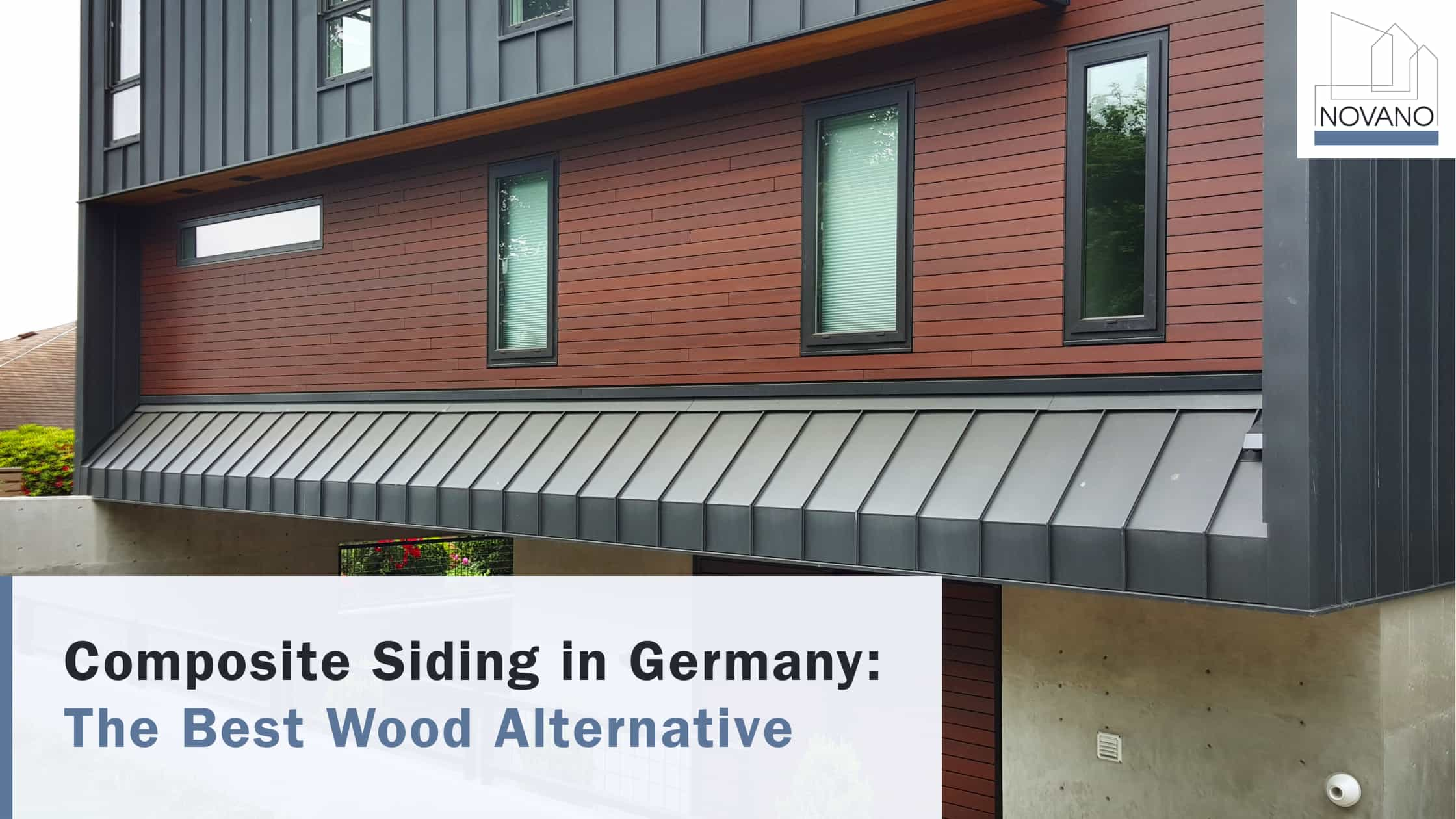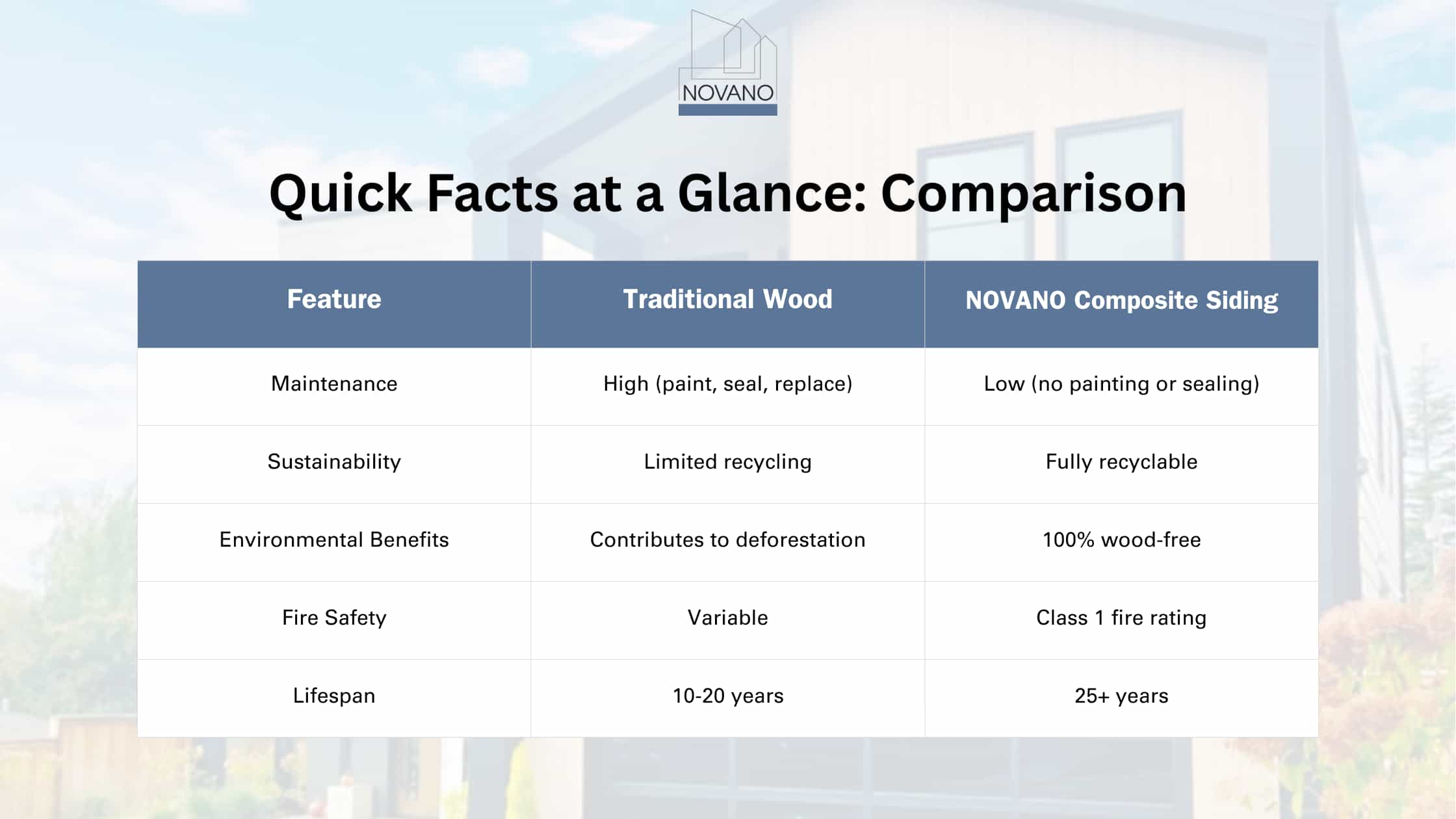
Summary
Composite siding is transforming German architecture with wood-like aesthetics, superior durability, and sustainable performance. Resistant to weather, fire, and decay, it aligns with green building standards. Novano provides architects with reliable, recyclable, and elegant siding for future-ready façades.
- Summary
- Key Takeaways
- The Limits of Traditional Wood Siding
- Why Architects Are Rethinking Siding?
- What Makes Composite Siding Different?
- Aesthetic Advantages of Composite Siding
- Built for Germany’s Climate
- Eco-Performance & Standards
- Performance Benefits for German Architecture
- Novano: The Reliable Composite Siding Solution
- FAQs
Composite Siding in Germany: The Best Wood Alternative
Across Germany, architects are rethinking exterior materials. Timber, once the hallmark of façades, is now under scrutiny. Its charm is undeniable, yet frequent upkeep, risk of fire, and vulnerability to weather make it a less practical choice.
Composite siding is stepping in as a modern, sustainable alternative. It captures the natural appeal of wood while overcoming its weaknesses. For German architects, this balance of design, durability, and environmental responsibility makes composite siding the best path forward.
Key Takeaways
✓ Wood siding struggles with durability and maintenance under Germany’s climate. Harsh weather and high upkeep costs make it less practical for long-term building projects.
✓ Composite siding provides wood-like aesthetics with superior long-term performance. It outlasts timber, requires minimal maintenance, and still delivers the warmth of wood.
✓ Novano offers architects reliable siding solutions that combine design, safety, and durability. Fully recyclable, it supports Germany’s sustainability and green building goals.
The Limits of Traditional Wood Siding
Wood siding holds cultural and aesthetic value, but it struggles under Germany’s variable climate. Heavy rain, icy winters, and humid summers expose wood to swelling, cracking, and decay. Even treated timber eventually weathers.
Maintenance is another challenge. Wooden façades demand frequent painting, sealing, and repairs to remain presentable. Over a building’s lifespan, these costs add up.
Germany’s push toward sustainable, long-lasting construction is also leaving timber behind. As projects aim for low-carbon materials with longer lifecycles, traditional wood is proving less suited for tomorrow’s architecture.
Why Architects Are Rethinking Siding?
Traditional timber still looks good, but…
✘ It cracks and warps in Germany’s shifting weather.
✘ It needs constant sealing, painting, and costly upkeep.
✘ It doesn’t align with long-term sustainability goals.
Composite siding has emerged as a new standard, keeping the warmth of wood without its weaknesses.
What Makes Composite Siding Different?
Composite siding is designed with performance in mind. It combines recycled rice husks and renewable polymers to create a fully wood-free, recyclable material. Unlike timber, it doesn’t absorb water, attract insects, or warp with seasonal shifts.
Its resistance to UV rays ensures colour stability, and its non-porous surface keeps mould and rot away. Unlike vinyl, it delivers consistent strength without cracking in cold conditions.
For architects, the result is a material that looks timeless yet requires no ongoing sealing, staining, or painting. It maintains beauty and structure for decades with minimal intervention.

Aesthetic Advantages of Composite Siding
Visual appeal is essential in German architecture, where façades often blend heritage inspiration with modern design. Composite siding is crafted to mimic the warmth and grain of real wood while offering consistency in finish.
Available in contemporary colours and textures, it adapts to sleek commercial façades, warm residential projects, and creative hospitality spaces. Whether the goal is minimalism or traditional warmth, composite siding delivers design flexibility without compromising performance.
This combination ensures that beauty and practicality work hand in hand.
Built for Germany’s Climate
Composite siding is a strong match for local conditions:
✔ Withstands freezing winters without cracking
✔ Handles damp summers without swelling
✔ Fire-rated for safety in dense urban buildings
Long lifespan = lower costs. Over decades, it outperforms timber and reduces replacement cycles.
Eco-Performance & Standards
Sustainability is no longer optional, it has become a defining factor in how projects are designed, approved, and built. Across Germany, architects are expected to meet high environmental benchmarks while still delivering beauty and durability.
Choosing materials that perform well over time, reduce carbon footprints, and align with recognised certifications is now essential to modern architecture. Composite siding helps meet these expectations by offering both resilience and responsibility.
✔ Fully recyclable
✔ Reduces reliance on natural timber resources
✔ Aligned with LEED certification
✔ Fits Germany’s circular building goals
✔ Lowers long-term lifecycle costs
Performance Benefits for German Architecture
Germany’s climate demands resilience. Composite siding holds up against sub-zero winters, damp summers, and persistent rainfall without swelling or cracking.
Its fire resistance adds another layer of protection, complying with European safety standards critical in dense urban areas. With a long service life, it significantly reduces replacement cycles and maintenance budgets.
In practice, architects gain a material that performs consistently across decades, providing assurance for both functional and financial planning.
Novano: The Reliable Composite Siding Solution
Novano’s composite siding is tailored for the demands of German architecture. Crafted from recycled rice husks and renewable polymers, it is completely wood-free and engineered for longevity. With a Class A fire rating, it adds security without sacrificing style.
Novano offers architects the balance of beauty, strength, and environmental responsibility. For façades that must perform as well as they inspire, Novano provides a trusted material choice. Discover the full range of composite siding options designed for future-ready projects at Novano Building Products Europe. Get FREE Samples today!
FAQs
Why is composite siding considered the best alternative to wood in Germany?
It combines the natural look of wood with higher durability, fire safety, and sustainability, making it ideal for German façades.
How does composite siding perform in Germany’s changing climate?
It withstands cold winters, humid summers, and heavy rain without warping, cracking, or decaying.
What sustainability and safety benefits does Novano composite siding offer architects?
Novano composite siding is fully recyclable and designed to support circular building practices. It aligns with leading certifications such as LEED, helping architects meet strict sustainability goals. With a Class A fire rating, it also delivers proven safety performance, ensuring façades are not only environmentally responsible but also secure for modern German architecture.

